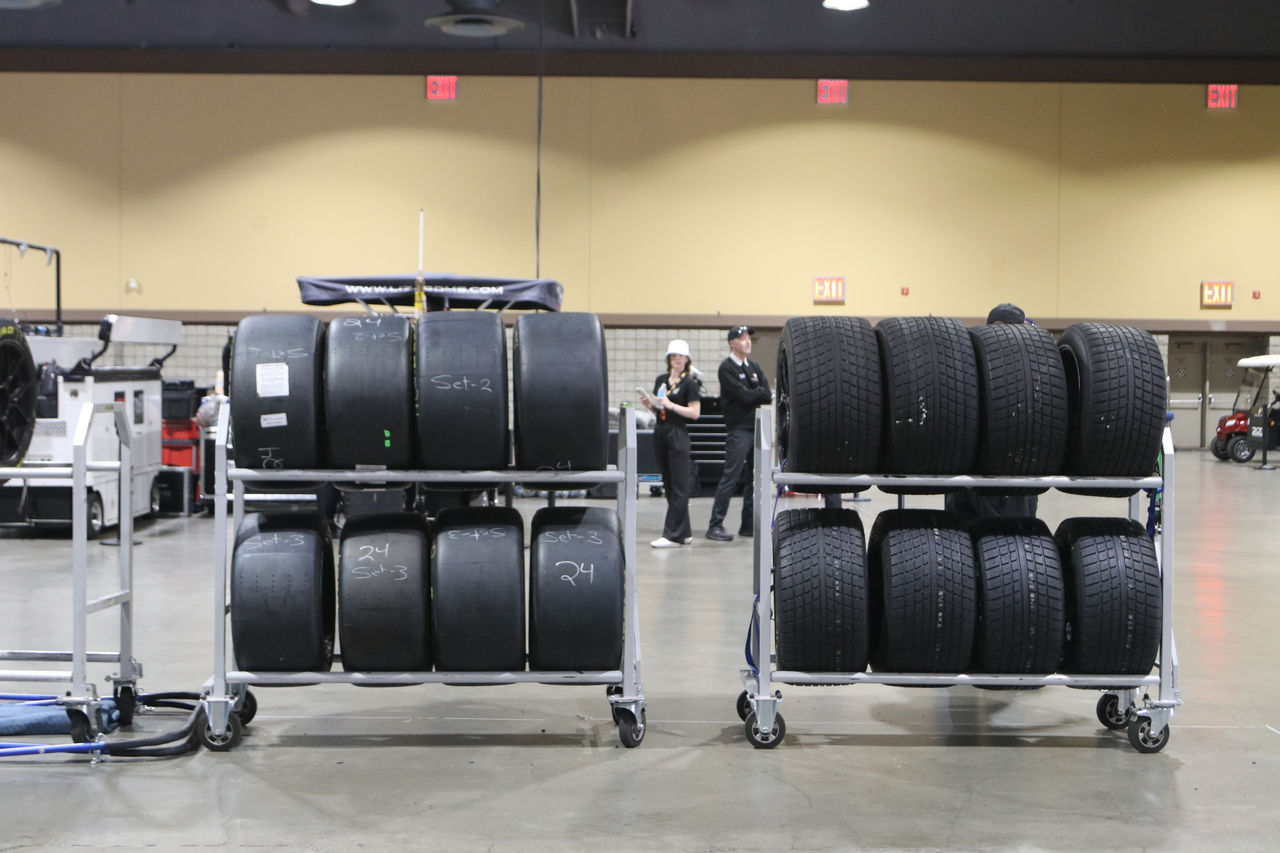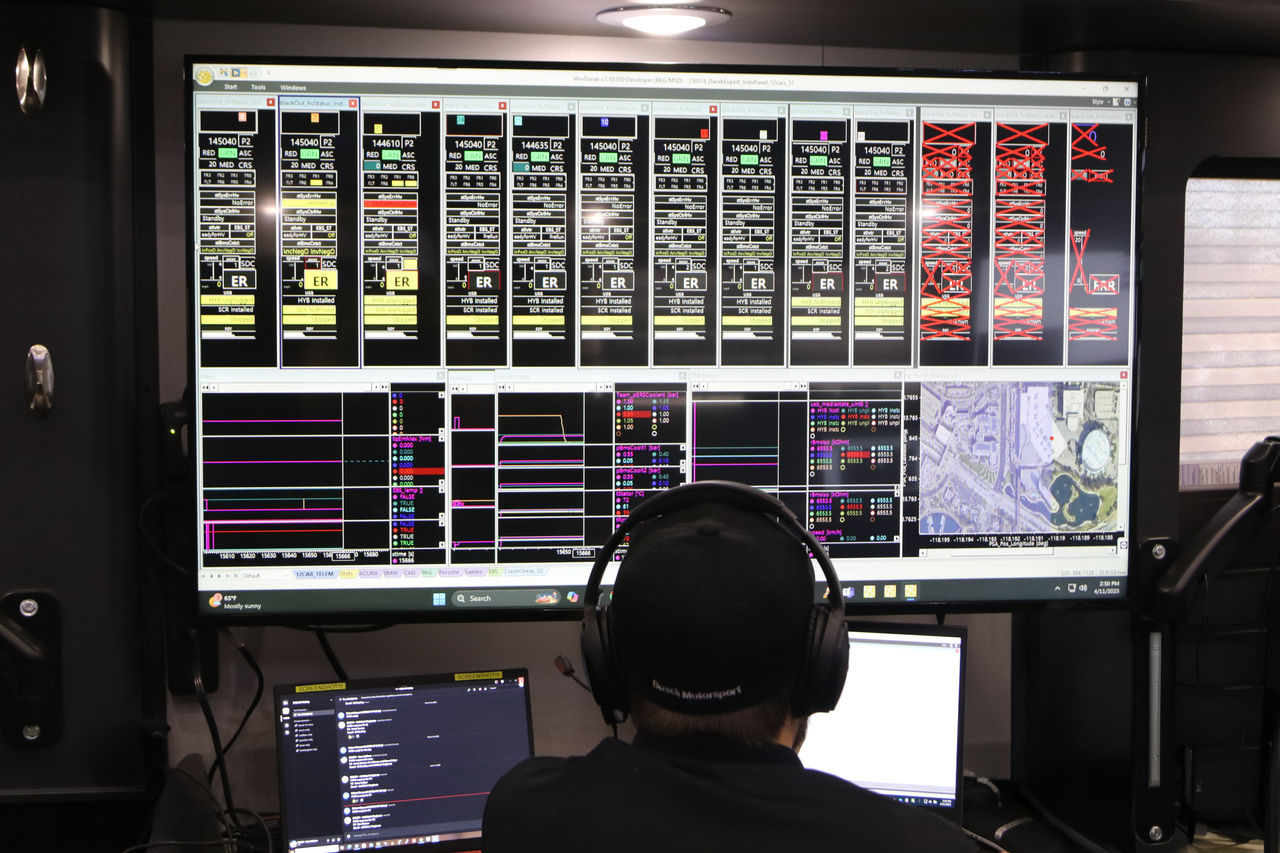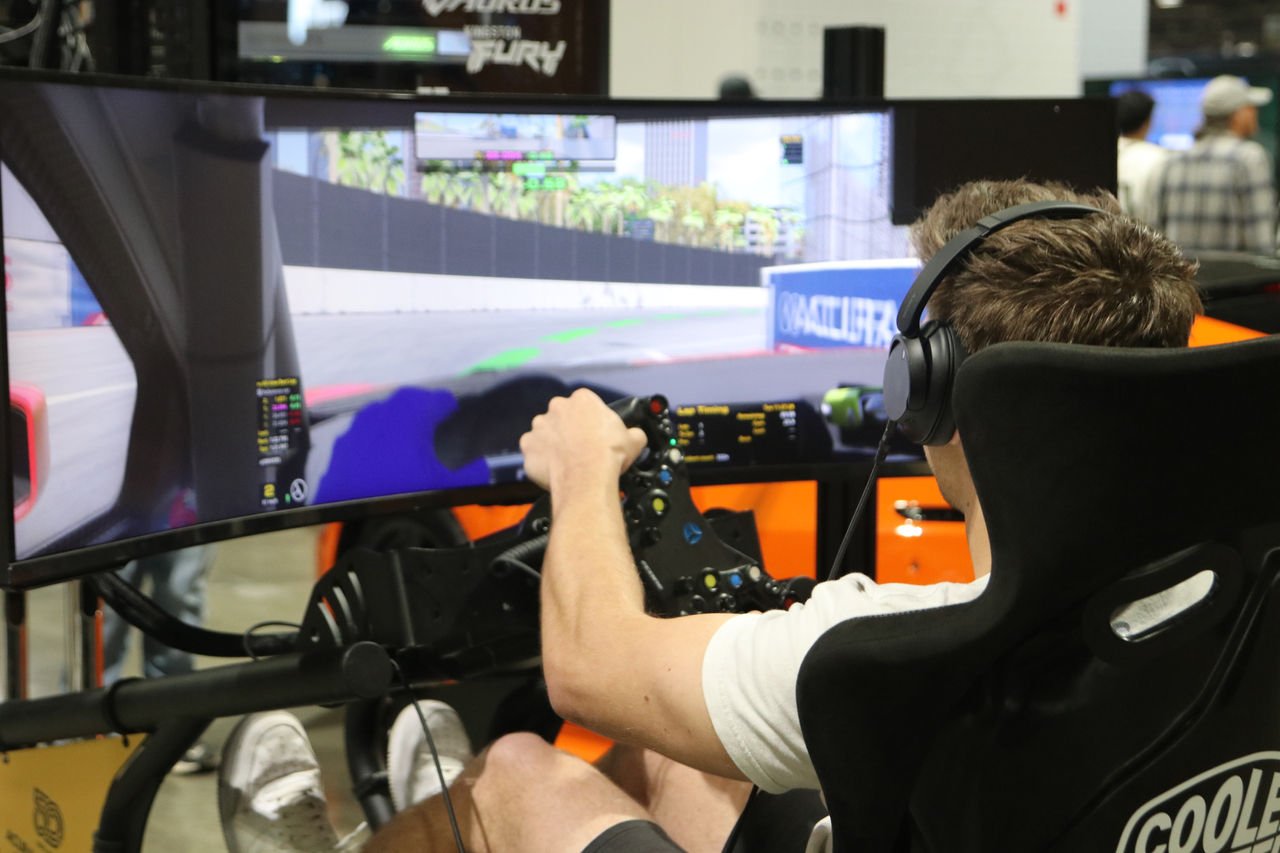Data at 200MPH
How motorsports teams leverage data for competitive advantage.
Written by Jenna Belhumeur | 18 min • June 18, 2025

Data at 200MPH
How motorsports teams leverage data for competitive advantage.
Written by Jenna Belhumeur | 18 min • June 18, 2025

On a sunny April morning at the 50th annual Acura Grand Prix in Long Beach, engines roar down Shoreline Drive, echoing off the cement buildings crowded along the coastline. Vendors call out over the noise, hawking earplugs to first-time spectators. Inside the entrance gates, crowds of people mill around, buying concessions to take back to the stands. They eagerly sit and wait for brief glimpses of superhero-like cars. Fast, dynamic and intelligent — at least in terms of how they’re engineered.
In the Team Penske paddock, a group of men in red jerseys are gathered around Scott McLaughlin’s No. 3 DEX Imaging Chevrolet. An engineer checks a laptop nearby, then returns to the vehicle, which is opened with all its internal workings on display. The engineer makes the rotation a few more times, relaying mathematically driven decisions from the screen to his teammates, who are fine-tuning one of the machine’s critical systems.
Races like the Grand Prix aren’t just won on the straights. They’re won through data — how it’s collected, interpreted and acted on in real time.
Today’s race cars carry more than 250 sensors, embedded across every major system — and not one is standardized. The sensors teams use, and how they use them, are largely up to their own discretion.
The only constraint placed on crews — one set by the governing body of the specific racing series — is on the vehicle’s metaphorical "brain": the ECU, or electronic control unit. The ECU determines how much sensor data can be processed at once. Limitations on data-processing are strictly enforced in Formula 1, where the rules are designed to maintain competitive parity and prevent wealthier teams from gaining an overwhelming technological advantage. Similar regulatory limits exist across other series, such as IndyCar and IMSA.
Richard Saxby is the motorsport director at McLaren Applied, the division responsible for building the engineering company’s electronic systems and software solutions. He’s also a former trackside engineer. Saxby puts it plainly: “You have some sensors that look at reliability and some that look at performance.” He then lists off a dizzying array of metrics: steering angle, steering torque, tire pressure, wheel speed, radiator pressure, fuel flow, hydraulic flow, gear position, ride height.
Tiny sensors embedded in the car’s floors and wings measure aerodynamic loads with the utmost precision, allowing technicians to later tweak the down force being generated (a quick aside in Newtonian physics: The more force pushed down into the ground, the more lateral forces and lateral acceleration can be generated). Some of the vehicle’s components are redundant, ensuring critical systems continue reporting data even if one sensor fails.
Each car is an impressively quantified specimen, one Saxby compares to an elite competitor. “It’s very much like how you would monitor a super high-performing athlete on a running machine before a competition,” he says. The engine is the car’s heart. The hydraulics, its blood pressure. The suspension and wheels, its limbs.
"A fast car used to be about pure mechanics. Now, it’s about data. "
But these days, it’s not just the mechanical components that matter. “If you take the computer from the engineer,” says Ingo Maul, vice president of motorsports at Bosch Engineering, “it’s like taking the smartphone from a teenager. They are not able to survive.” From Bosch headquarters in Abstatt, Germany, Maul emphasizes over a video call just how fundamentally the sport has shifted. A fast car used to be about pure mechanics. Now, it’s about data.
Information is transmitted via telemetry, a wireless communication system that sends data from the vehicle in real time. Cellular telemetry has been a revolution for racing series that permit it, replacing cumbersome radio infrastructure that had to be built around the track with something far more flexible.
“Now you literally only need a cellular connection on the car and an internet connection in the garage,” says Richard Hull, head of business development at McLaren Applied. Teams decide what to transmit live versus log for post-race analysis, keeping in mind the volume of the data with bandwidth limits imposed by the regulators.
Before the race begins, thousands of simulations have been run. Predictive modeling drives tactics: from the optimal time for refueling to how long a tire will maintain sufficient traction. Tire degradation is the “biggest thing” that most teams are looking at, says Nikhil Sawant, head of software products in motorsport at McLaren Applied. A data wizard one colleague admiringly referred to as "the Oracle," Sawant notes how teams can reverse-engineer tire behavior using real-time temperature, pressure and grip data.
Interestingly, Formula 1 crews don't receive the exact tires they'll be using until race weekends. Tires are tightly controlled by Pirelli and distributed shortly before drivers head to the starting line, preventing teams from tailoring their setups too perfectly in advance. Once the race is over, the tires are immediately reclaimed to prevent chemical analysis or dissection of wear patterns — a safeguard meant to keep the sport competitive and prevent better resourced teams from out-developing smaller ones mid-season. Nevertheless, crews experiment with virtual prototypes to compensate. “They try to almost beat the system,” Saxby says.
 Behind the scenes at Formula 1
Behind the scenes at Formula 1
These simulations extend far beyond tires. Fuel mapping is utilized to calculate the most efficient burn rate across different segments of a track. Some even incorporate weather forecasts and predictive positioning models of competitors, running through countless combinations of how a race might unfold.
Each car has a kind of digital twin, a virtual version of the machine that attempts to mirror every scenario. Drivers enter a race weekend with many strategic decisions already made, like how fast they’ll take specific turns and when they’ll halt at the pit. “If they don’t calculate correctly,” Maul warns, “they stop before the finish line.”
That’s exactly what happened at the infamous 2016 Le Mans race, a 24-hour endurance event in France. In the final three minutes, Toyota’s No. 5 leading driver lost power and came to a complete standstill, allowing Porsche to pass him on the final lap. The faces of the Toyota team's heartbroken engineers, watching the disaster unfold in real time, have garnered close to a million views on YouTube.
Scrutineering, a clever portmanteau fusing scrutiny with engineering, is the process by which officials confirm that every car complies with the rules. It ensures accountability. From mechanical configuration to software behavior, it's racing’s version of a technical inspection.
At the Long Beach Grand Prix, Bosch takes on this regulatory watchdog role for IMSA, one of the series racing throughout the three-day event. Senior Software Engineer/scrutineer Alex Simone, stationed inside Bosch's mobile operations unit in a neighboring lot, uses software to scan for patterns and outliers on graphs that would be nonsensical for most outside her field. Sometimes, she says, it’s not only about the computer work. She must physically walk to a team’s car to check something out. A handful of others donning the signature black Bosch polos sit side-by-side in the narrow confines of the trailer, eyes fixed on monitors. Simone's workstation serves as a window into Bosch’s authority. Here, she and her colleagues aren’t chasing speed, but catching mistakes. They relay significant abnormalities they uncover to the race’s governing officials.
In IMSA, for instance, crews are limited in how much boost they can generate from their engines. A sudden spike might mean someone’s flirting with the threshold or crossing it. Throttle inputs and brake behavior are also monitored, along with ECU software signatures. Any deviation from the approved profile, even by a fraction, can result in penalties. This real-time enforcement is what allows series like IMSA to maintain fairness without slowing down the spectacle.
The scale of data work for scrutineers is enormous. As Ingo Maul, the vice president of Bosch's motorsports division, notes, for every endurance competition, Bosch might receive 500 gigabytes of data per car. Multiply that by a full race grid, and you begin to understand why these referees have gone digital.
Back inside the Bosch truck, Motorsport Operations Lead Brooke Bond shows off a small, unassuming black box: the HCU 50.4. It’s a data logger that captures real-time telemetry directly from each auto’s ECU, helping officials track parameters like power output, throttle input and software compliance. The HCU 50.4 is just one device in Bosch’s arsenal. For certain series, Bosch also employs a suite of additional monitoring tools designed to track various aspects of engine and vehicle performance. They help verify compliance across a broad range of parameters — whether a car is emitting more than it should, or if a system is reacting differently than expected.
IMSA’s trust in the German technology company makes sense. Unlike a racing group, Bosch has no skin in the game. Their neutrality ensures fairness as they work alongside the event’s governing authority. If a violation is confirmed, sanctions range from time penalties to disqualification, depending on the severity of the infraction.
Meanwhile, individual teams are expanding data operations through their own remote units — often referred to as “war rooms.” Analysts based thousands of miles away can watch a livestream of sensor data and help decide whether it’s time to pit, conserve fuel or push harder — essentially co-piloting the driver from afar.
 A remote unit team at Formula 1
A remote unit team at Formula 1
“You’ll have a team back at the factory in the UK or Germany or Italy working exactly as if they were on the pit wall,” Hull explains. In Formula 1, that remote crew can number in the hundreds, with each engineer focused on a specialized domain, from tire wear analysis to suspension modeling. The ability to transmit and share information remotely has made these global collaborations practically seamless.
Formula 1 remains differentiated from other racing series by its size and resources. With often more than 1,000 employees on a team, Maul says, “They analyze everything.” While a GT3 crew in the German Touring Car Championship might have one single data scientist examining performance, a Formula 1 crew could have five focused just on tire strategy.
This degree of technical evaluation creates an arms race of information. “One engineer is just looking at temperature sensors,” Maul says. “Another only at ride height. That’s the level of detail.” The entire operation allows for minute optimizations and tweaks that, in aggregate, may shave tenths of a second off a lap.
But even in this world of quantitative obsession, the human component remains irreplaceable. “The driver is probably the biggest sensor in the car,” according to Saxby.
And that sensor speaks its own language. Saxby recalls a former driver once telling him the car felt “wishy-washy” and “a bit speed boaty” after a run. Saxby chuckles: “You wonder, what does that even mean?” Part of his job was interpreting driver feedback in the actual data. Maybe the steering feedback changed under load? Maybe the rear end was unstable? That could have resulted in the familiar “speed boaty” feeling of being up in the air while bouncing along, Saxby muses.
A “good engineer,” he says, learns how to match language to metrics. Eventually, the more they work together, this “language” becomes a shared vocabulary between technician and driver, leading to more intuitive adjustments.
Still, many of those within motorsports run the risk of being too engrossed in the numbers. Saxby remembers once sitting on the pit wall, monitoring incoming statistics with a colleague. “He looks at his screen and says, ‘It’s going to rain in five minutes.’ But if he had just looked around, he would’ve noticed it was already raining!” The anecdote speaks volumes about the limits of data. Human drivers can bring instinct, perception and, at times, a grounding reality to the situations at hand.
Rob Smedley, a former Ferrari race engineer and longtime Formula 1 veteran, recently joined the Harvard Data Science Review Podcast to discuss how data is reshaping the sport. He emphasized that it’s not just about finding speed, it’s about synchronizing man and machine. “You’re not just optimizing the car or the driver, you’re optimizing the interaction between the two,” he says. That fluid exchange between the driver’s physical inputs and the digital signals from the vehicle is what makes motorsport uniquely compelling. It enables performance gains no algorithm alone can yet replicate.
After being shipped in protective containers, then reassembled and recalibrated onsite, the IndyCars competing at the Long Beach Grand Prix are pushed to the starting line. It’s the moment those behind the scenes have been working toward for months — poring over the figures, preparing for every conceivable scenario.
This obsessive planning process has made motorsport one of the most technically advanced industries on the planet. Increasingly, companies from outside the racing world are taking note. Airlines, logistics firms and manufacturers have consulted with motorsport engineers to learn how they manage complexity, speed and failure.
"When something goes wrong in a sprint, the consequences are immediate and visible. In corporate environments, lessons from the track can be applied. "
When something goes wrong in a sprint, the consequences are immediate and visible. That urgency forces engineers to build resilient systems, react quickly and anticipate issues before they arise. In corporate environments where synchronized workflows, predictive maintenance and agile decision-making are critical, lessons from the track can be applied.
Professional racing teaches not just how to go fast, but how to make sure one’s assets are performing as they should.
The same data systems developed by McLaren Applied to monitor their Formula 1 cars now help companies like Brightline and Amtrak optimize train performance. In Malaysia, McLaren helped a mining company monitor its massive fuel-guzzling trucks using basic sensors to track wheel speed, fuel consumption and steering angle. By using their proprietary ATLAS (Advanced Telemetry Linked Acquisition System) software to analyze these inputs, they created optimized paths that allowed the heavy trucks to efficiently pass one another, rather than constantly braking and stepping on the gas again. “It saved them hundreds of thousands of dollars in fuel,” Saxby notes.
Racing tech has even made its way into neonatal care. “We adapted our ECU to monitor a baby’s vitals,” Hull recalls. Using the same real-time data streaming tools they’d use on a race car, McLaren helped hospitals track heart rate, breathing patterns and other signs of infant stress. Doctors could then infer if they needed to increase an IV’s drip concentration. “We were very much part of the proof of concept,” he says, “and [the hospital] built their own system to then do what we were doing.”
When it comes to technology, the idea that there’s room for growth is omnipresent. For all the complexity already built into motorsports, many experts believe this might only be the tip of the iceberg. As AI systems become more sophisticated, the role of machine learning in racing is likely to rise.
Smedley lets his imagination run wild with the possibilities. He envisions a day when it’s feasible to use neural networks to model not just the car, but the driver’s behavior. One could then simulate and optimize the driver-car combination as a single unified system.
In theory, this could allow teams to test thousands of strategies not just based on physics and mechanics but on how a specific driver brakes, accelerates or reacts under pressure. A digital version of Lewis Hamilton or Max Verstappen could be plugged into predictive simulations, yielding even more realistic forecasts.
The challenge? Ensuring synchronized and accurate measurements. Scientists sometimes refer to this as “clean” data. It’s easy for data to quickly become compromised: A car going around a track at over 200 mph could accidentally jostle one of its sensors. Of 10 different data sources that may need to be aligned, one could fall out of sync.
“There are many companies that rely on data but don’t have truly sanitized data,” Smedley emphasizes. In motorsports, that means matching up timing, weather feeds, track sensors, etc. — all to the millisecond. If just one signal is out of sync, the insights break down. Small margins have a big impact.
Surrogate modeling — where simplified, data-driven mockups are used to approximate the results of complex simulations — must be accurate to within a fraction of a percent to provide insights that racing teams can confidently incorporate into car designs. “We need to be down to less than 1 percent [error] in areas of extrapolation. And even less than that once we get to a mature part of the design cycle,” Smedley notes. “If you go to environments outside of Formula 1, I would say correlation with traditional simulation and modeling and stuff like that is probably less, much less than what I've just described.”
Some within the top-tier racing series have already begun incorporating limited forms of AI into their workflows. Driver-in-the-loop simulators, for example, pair real drivers with AI-generated race conditions to rehearse strategy and optimize reflexes. Others are exploring how AI can help engineers prioritize which data set to consider first during time-constrained decision windows.
 An attendee drives a simulation at the Formula 1 race
An attendee drives a simulation at the Formula 1 race
Even the scrutineering side may evolve. Maul mentions that Bosch is working to develop a platform that integrates all regulatory systems into the cloud, making it easier for officials, teams and even fans to access race analytics in real time. And as this data becomes more accessible and more immediate, new forms of engagement will begin to emerge.
Maul can foresee a future in which esports fans battle virtually alongside professionals using real-time figures streamed from the cars. Similarly, Saxby envisions a world of “armchair engineers.” Imagine fans watching at home, running ghost simulations, analyzing sector times and making live predictions. “Augmented reality commentary,” in Saxby’s words, could also become a trend in the industry. “Commentary could be AI. It doesn't necessarily have to be a commentator.”
Data won’t just power the cars, it will power the fan experience.
As the afternoon rolls on in Long Beach, the grandstands continue to buzz. After crossing the finish line during his practice session, Mexican driver Pato O’Ward walks through the paddock, sipping a canned energy drink following an exhilarating performance. He’s immediately flanked by fans. One asks him to autograph her arm.
On the other side of the paddock, the red-shirted Team Penske members have just finished their latest ECU tweak and are moving on to something else. Back inside the Bosch truck, Alex Simone remains focused at her station, scanning telemetry graphs and diligently tracking who’s playing by the rules.
And outside the 50th annual Acura Grand Prix, hawkers continue to sell earplugs, while teenagers who recently unlocked a new passion for esports racing walk smiling through the entrance gates.